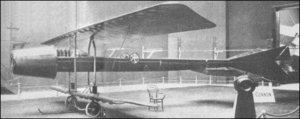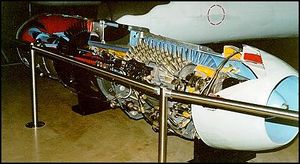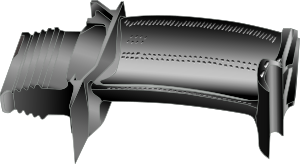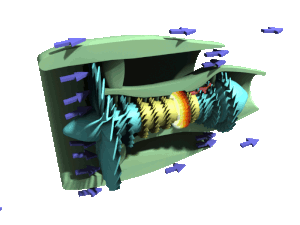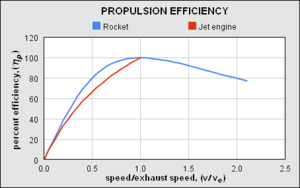Jet engine
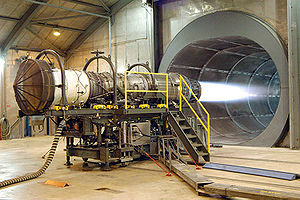
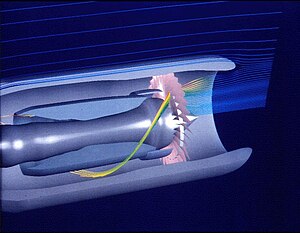
A jet engine is a reaction engine that discharges a fast moving jet of fluid to generate thrust in accordance with Newton's laws of motion. This broad definition of jet engines includes turbojets, turbofans, rockets, ramjets, pulse jets and pump-jets. In general, most jet engines are internal combustion engines[1] but non-combusting forms also exist.
In some common parlance, the term 'jet engine' is loosely referred to an internal combustion duct engine, which typically consists of an engine with a rotary (rotating) air compressor powered by a turbine ("Brayton cycle"), with the leftover power providing thrust via a propelling nozzle. These types of jet engines are primarily used by jet aircraft for long distance travel. The early jet aircraft used turbojet engines which were relatively inefficient for subsonic flight. Modern subsonic jet aircraft usually use high-bypass turbofan engines which help give high speeds as well as, over long distances, giving better fuel efficiency than many other forms of transport.
About 7.2% of the oil used in 2004 was ultimately consumed by jet engines.[2] In 2007, the cost of jet fuel, while highly variable from one airline to another, averaged 26.5% of total operating costs, making it the single largest operating expense for most airlines.[3]
History
Jet engines can be dated back to the invention of the aeolipile before the first century AD. This device used steam power directed through two nozzles so as to cause a sphere to spin rapidly on its axis. So far as is known, it was not used for supplying mechanical power, and the potential practical applications of this invention were not recognized. It was simply considered a curiosity.
Jet propulsion only literally and figuratively took off with the invention of the rocket by the Chinese in the 13th century. Rocket exhaust was initially used in a modest way for fireworks but gradually progressed to propel formidable weaponry; and there the technology stalled for hundreds of years.
Archytas, the founder of mathematical mechanics, as described in the writings of Aulus Gellius five centuries after him, was reputed to have designed and built the first artificial, self-propelled flying device. This device was a bird-shaped model propelled by a jet of what was probably steam, said to have actually flown some 200 meters.
In Ottoman Turkey in 1633 Lagari Hasan Çelebi took off with what was described to be a cone-shaped rocket and then glided with wings into a successful landing, winning a position in the Ottoman army. However, this was essentially a stunt. The problem was that rockets are simply too inefficient at low speeds to be useful for general aviation.
In 1910 Henri Coandă designed, built and piloted the first 'thermojet'-powered aircraft, known as the Coandă-1910, which he demonstrated publicly at the second International Aeronautic Salon in Paris. The powerplant used a 4-cylinder piston engine to power a compressor, which fed two burners for thrust, instead of using a propeller. At the airport of Issy-les-Moulineaux near Paris, Coandă lost control of the jet plane, which went off of the runway and caught fire. Fortunately, he escaped with minor injuries to his face and hands. Around that time, Coandă abandoned his experiments due to a lack of interest from the public, scientific and engineering institutions. It would be nearly 30 years until the next thermojet-powered aircraft, the Caproni Campini N.1 (sometimes referred to as C.C.2).
In 1913 René Lorin came up with a form of jet engine, the subsonic pulsejet, which would have been somewhat more efficient, but he had no way to achieve high enough speeds for it to operate, and the concept remained theoretical for quite some time.
However, engineers were beginning to realize that the piston engine was self-limiting in terms of the maximum performance which could be attained; the limit was essentially one of propeller efficiency.[4] This seemed to peak as blade tips approached the speed of sound. If engine, and thus aircraft, performance were ever to increase beyond such a barrier, a way would have to be found to radically improve the design of the piston engine, or a wholly new type of powerplant would have to be developed. This was the motivation behind the development of the gas turbine engine, commonly called a "jet" engine, which would become almost as revolutionary to aviation as the Wright brothers' first flight.
The earliest attempts at jet engines were hybrid designs in which an external power source first compressed air, which was then mixed with fuel and burned for jet thrust. In one such system, called a thermojet by Secondo Campini but more commonly, motorjet, the air was compressed by a fan driven by a conventional piston engine. Examples of this type of design were Henri Coandă's Coandă-1910 aircraft, and the much later Campini Caproni CC.2, and the Japanese Tsu-11 engine intended to power Ohka kamikaze planes towards the end of World War II. None were entirely successful and the CC.2 ended up being slower than the same design with a traditional engine and propeller combination.
The key to a practical jet engine was the gas turbine, used to extract energy from the engine itself to drive the compressor. The gas turbine was not an idea developed in the 1930s: the patent for a stationary turbine was granted to John Barber in England in 1791. The first gas turbine to successfully run self-sustaining was built in 1903 by Norwegian engineer Ægidius Elling. Limitations in design and practical engineering and metallurgy prevented such engines reaching manufacture. The main problems were safety, reliability, weight and, especially, sustained operation.
In Hungary, Albert Fonó in 1915 devised a solution for increasing the range of artillery, comprising a gun-launched projectile which was to be united with a ramjet propulsion unit. This was to make it possible to obtain a long range with low initial muzzle velocities, allowing heavy shells to be fired from relatively lightweight guns. Fonó submitted his invention to the Austro-Hungarian Army but the proposal was rejected. In 1928 he applied for a German patent on aircraft powered by supersonic ramjets, and this was awarded in 1932.[5][6][7]
The first patent for using a gas turbine to power an aircraft was filed in 1921 by Frenchman Maxime Guillaume.[8] His engine was an axial-flow turbojet.
In 1923, Edgar Buckingham of the US National Bureau of Standard published a report[9] expressing scepticism that jet engines would be economically competitive with prop driven aircraft at the low altitudes and airspeeds of the period: "there does not appear to be, at present, any prospect whatever that jet propulsion of the sort here considered will ever be of practical value, even for military purposes."
Instead, by the 1930s, the piston engine in its many different forms (rotary and static radial, aircooled and liquid-cooled inline) was the only type of powerplant available to aircraft designers. This was acceptable as long as only low performance aircraft were required, and indeed all that were available.
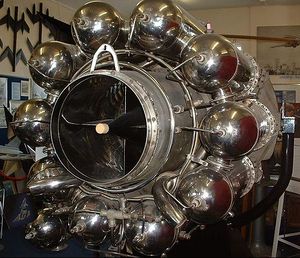
In 1928, RAF College Cranwell cadet [10]Frank Whittle formally submitted his ideas for a turbo-jet to his superiors. In October 1929 he developed his ideas further.[11] . On 16 January 1930 in England, Whittle submitted his first patent (granted in 1932).[12] The patent showed a two-stage axial compressor feeding a single-sided centrifugal compressor. Practical axial compressors were made possible by ideas from A.A.Griffith in a seminal paper in 1926 ("An Aerodynamic Theory of Turbine Design"). Whittle would later concentrate on the simpler centrifugal compressor only, for a variety of practical reasons. Whittle had his first engine running in April 1937. It was liquid-fuelled, and included a self-contained fuel pump. Whittle's team experienced near-panic when the engine would not stop, accelerating even after the fuel was switched off. It turned out that fuel had leaked into the engine and accumulated in pools. So the engine would not stop until all the leaked fuel had burned off. Whittle was unable to interest the government in his invention, and development continued at a slow pace.

In 1935 Hans von Ohain started work on a similar design in Germany, apparently unaware of Whittle's work.[13] His first engine was strictly experimental and could only run under external power, but he was able to demonstrate the basic concept. Ohain was then introduced to Ernst Heinkel, one of the larger aircraft industrialists of the day, who immediately saw the promise of the design. Heinkel had recently purchased the Hirth engine company, and Ohain and his master machinist Max Hahn were set up there as a new division of the Hirth company. They had their first HeS 1 centrifugal engine running by September 1937. Unlike Whittle's design, Ohain used hydrogen as fuel, supplied under external pressure. Their subsequent designs culminated in the gasoline-fuelled HeS 3 of 1,100 lbf (5 kN), which was fitted to Heinkel's simple and compact He 178 airframe and flown by Erich Warsitz in the early morning of August 27, 1939, from Rostock-Marienehe aerodrome, an impressively short time for development. The He 178 was the world's first jet plane.
The world's first turboprop was the Jendrassik Cs-1 designed by the Hungarian mechanical engineer György Jendrassik. It was produced and tested in the Ganz factory in Budapest between 1938 and 1942. It was planned to fit to the Varga RMI-1 X/H twin-engined reconnaissance bomber designed by László Varga in 1940, but the program was cancelled. Jendrassik had also designed a small-scale 75 kW turboprop in 1937.
Whittle's engine was starting to look useful, and his Power Jets Ltd. started receiving Air Ministry money. In 1941 a flyable version of the engine called the W.1, capable of 1000 lbf (4 kN) of thrust, was fitted to the Gloster E28/39 airframe specially built for it, and first flew on May 15, 1941 at RAF Cranwell.

A Scottish aircraft engine designer, Frank Halford, working from Whittle's ideas developed a "straight through" version of the centrifugal jet; his design became the de Havilland Goblin.
One problem with both of these early designs, which are called centrifugal-flow engines, was that the compressor worked by "throwing" (accelerating) air outward from the central intake to the outer periphery of the engine, where the air was then compressed by a divergent duct setup, converting its velocity into pressure. An advantage of this design was that it was already well understood, having been implemented in centrifugal superchargers, then in widespread use on piston engines. However, given the early technological limitations on the shaft speed of the engine, the compressor needed to have a very large diameter to produce the power required. This meant that the engines had a large frontal area, which made it less useful as an aircraft powerplant due to drag. A further disadvantage was that the air flow had to be "bent" to flow rearwards through the combustion section and to the turbine and tailpipe, adding complexity and lowering efficiency. Nevertheless, these types of engines had the major advantages of light weight, simplicity and reliability, and development rapidly progressed to practical airworthy designs.
Austrian Anselm Franz of Junkers' engine division (Junkers Motoren or Jumo) addressed these problems with the introduction of the axial-flow compressor. Essentially, this is a turbine in reverse. Air coming in the front of the engine is blown towards the rear of the engine by a fan stage (convergent ducts), where it is crushed against a set of non-rotating blades called stators (divergent ducts). The process is nowhere near as powerful as the centrifugal compressor, so a number of these pairs of fans and stators are placed in series to get the needed compression. Even with all the added complexity, the resulting engine is much smaller in diameter and thus, more aerodynamic. Jumo was assigned the next engine number in the RLM numbering sequence, 4, and the result was the Jumo 004 engine. After many lesser technical difficulties were solved, mass production of this engine started in 1944 as a powerplant for the world's first jet-fighter aircraft, the Messerschmitt Me 262 (and later the world's first jet-bomber aircraft, the Arado Ar 234). A variety of reasons conspired to delay the engine's availability, this delay caused the fighter to arrive too late to decisively impact Germany's position in World War II. Nonetheless, it will be remembered as the first use of jet engines in service.
In the UK, their first axial-flow engine, the Metrovick F.2, ran in 1941 and was first flown in 1943. Although more powerful than the centrifugal designs at the time, the Ministry considered its complexity and unreliability a drawback in wartime. The work at Metrovick led to the Armstrong Siddeley Sapphire engine which would be built in the US as the J65.
Following the end of the war the German jet aircraft and jet engines were extensively studied by the victorious allies and contributed to work on early Soviet and US jet fighters. The legacy of the axial-flow engine is seen in the fact that practically all jet engines on fixed wing aircraft have had some inspiration from this design.
Centrifugal-flow engines have improved since their introduction. With improvements in bearing technology the shaft speed of the engine was increased, greatly reducing the diameter of the centrifugal compressor. The short engine length remains an advantage of this design, particularly for use in helicopters where overall size is more important than frontal area. Also as their engine components are more robust they are less liable to foreign object damage than axial-flow compressor engines.
Although German designs were more advanced aerodynamically, the combination of simplicity and Britain's war-time availability of requisite rare metals for the necessary advanced metallurgy (such as tungsten, chromium and titanium) for high-stress components such as turbine blades and bearings, etc) meant that Whittle-derived designs were generally more reliable than their German counterparts. British engines were also widely manufactured under license in the US (see Tizard Mission), and were sold to Soviet Russia who reverse engineered them with the Nene going on to power the famous MiG-15. American and Soviet designs, independent axial-flow types for the most part, would strive to attain superior performance until the 1960s, although the General Electric J47 provided excellent service in the F-86 Sabre in the 1950s.
By the 1950s the jet engine was almost universal in combat aircraft, with the exception of cargo, liaison and other specialty types. By this point some of the British designs were already cleared for civilian use, and had appeared on early models like the de Havilland Comet and Avro Canada Jetliner. By the 1960s all large civilian aircraft were also jet powered, leaving the piston engine in such low-cost niche roles such as cargo flights.
Relentless improvements in the turboprop pushed the piston engine (an internal combustion engine) out of the mainstream entirely, leaving it serving only the smallest general aviation designs and some use in drone aircraft. The ascension of the jet engine to almost universal use in aircraft took well under twenty years.
However, the story was not quite at an end, for the efficiency of turbojet engines was still rather worse than piston engines, but by the 1970s with the advent of high bypass jet engines, an innovation not foreseen by the early commentators like Edgar Buckingham, at high speeds and high altitudes that seemed absurd to them, only then did the fuel efficiency finally exceed that of the best piston and propeller engines,[14] and the dream of fast, safe, economical travel around the world finally arrived, and their dour, if well founded for the time, predictions that jet engines would never amount to much, were killed forever.
Types
There are a large number of different types of jet engines, all of which achieve forward thrust from the principle of jet propulsion.
| Type | Description | Advantages | Disadvantages |
|---|---|---|---|
| Water jet | For propelling water rockets and jetboats; squirts water out the back through a nozzle | In boats, can run in shallow water, high acceleration, no risk of engine overload (unlike propellers), less noise and vibration, highly maneuverable at all boat speeds, high speed efficiency, less vulnerable to damage from debris, very reliable, more load flexibility, less harmful to wildlife | Can be less efficient than a propeller at low speed, more expensive, higher weight in boat due to entrained water, will not perform well if boat is heavier than the jet is sized for |
| Motorjet | Works like a turbojet but instead of a turbine driving the compressor a piston engine drives it. | Higher exhaust velocity than a propeller, offering better thrust at high speed | Heavy, inefficient and underpowered. Examples include: Coandă-1910 and Caproni Campini N.1. |
| Turbojet | A tube with a compressor and turbine sharing a common shaft with a burner in between and a propelling nozzle for the exhaust.[15] Uses a high exhaust gas velocity to produce thrust. Has a much higher core flow than bypass type engines | Simplicity of design, efficient at supersonic speeds (~M2) | A basic design, misses many improvements in efficiency and power for subsonic flight, relatively noisy. |
| Low-bypass Turbofan | One- or two-stage fan added in front bypasses a proportion of the air through a bypass duct straight to the nozzle/afterburner, avoiding the combustion chamber, with the rest being heated in the combustion chamber and passing through the turbine.[16] Compared with its turbojet ancestor, this allows for more efficient operation with somewhat less noise. This is the engine of high-speed military aircraft, some smaller private jets, and older civilian airliners such as the Boeing 707, the McDonnell Douglas DC-8, and their derivatives. | As with the turbojet, the design is aerodynamic, with only a modest increase in diameter over the turbojet required to accommodate the bypass fan and chamber. It is capable of supersonic speeds with minimal thrust drop-off at high speeds and altitudes yet still more efficient than the turbojet at subsonic operation. | Noisier and less efficient than high-bypass turbofan, with less static (Mach 0) thrust. Added complexity to accommodate dual shaft designs. More inefficient than a turbojet around M2 due to higher cross-sectional area. |
| High-bypass Turbofan | First stage compressor drastically enlarged to provide bypass airflow around engine core, and it provides significant amounts of thrust. Compared to the low-bypass turbofan and no-bypass turbojet, the high-bypass turbofan works on the principle of moving a great deal of air somewhat faster, rather than a small amount extremely fast.[16] Most common form of jet engine in civilian use today- used in airliners like the Boeing 747, most 737s, and all Airbus aircraft. | Quieter around 10 to 20 percent more than the turbojet engine due to greater mass flow and lower total exhaust speed and more efficient for a useful range of subsonic airspeeds for same reason, cooler exhaust temperature. Less noisy and exhibit much better efficiency than low bypass turbofans. | Greater complexity (additional ducting, usually multiple shafts) and the need to contain heavy blades. Fan diameter can be extremely large, especially in high bypass turbofans such as the GE90. More subject to FOD and ice damage. Top speed is limited due to the potential for shockwaves to damage engine. Thrust lapse at higher speeds, which necessitates huge diameters and introduces additional drag. |
| Rocket | Carries all propellants and oxidants on-board, emits jet for propulsion[17] | Very few moving parts, Mach 0 to Mach 25+, efficient at very high speed (> Mach 5.0 or so), thrust/weight ratio over 100, no complex air inlet, high compression ratio, very high speed (hypersonic) exhaust, good cost/thrust ratio, fairly easy to test, works in a vacuum-indeed works best exoatmospheric which is kinder on vehicle structure at high speed, fairly small surface area to keep cool, and no turbine in hot exhaust stream. | Needs lots of propellant- very low specific impulse — typically 100-450 seconds. Extreme thermal stresses of combustion chamber can make reuse harder. Typically requires carrying oxidiser on-board which increases risks. Extraordinarily noisy. |
| Ramjet | Intake air is compressed entirely by speed of oncoming air and duct shape (divergent), and then it goes through a burner section where it is heated and then passes through a propelling nozzle[18] | Very few moving parts, Mach 0.8 to Mach 5+, efficient at high speed (> Mach 2.0 or so), lightest of all air-breathing jets (thrust/weight ratio up to 30 at optimum speed), cooling much easier than turbojets as no turbine blades to cool. | Must have a high initial speed to function, inefficient at slow speeds due to poor compression ratio, difficult to arrange shaft power for accessories, usually limited to a small range of speeds, intake flow must be slowed to subsonic speeds, noisy, fairly difficult to test, finicky to keep lit. |
| Turboprop (Turboshaft similar) | Strictly not a jet at all — a gas turbine engine is used as a powerplant to drive a propeller shaft (or rotor in the case of a helicopter) | High efficiency at lower subsonic airspeeds (300 knots plus), high shaft power to weight | Limited top speed (aeroplanes), somewhat noisy, complex transmission |
| Propfan/Unducted Fan | Turbojet engine that also drives one or more propellers. Similar to a turbofan without the fan cowling. | Higher fuel efficiency, potentially less noisy than turbofans, could lead to higher-speed commercial aircraft, popular in the 1980s during fuel shortages | Development of propfan engines has been very limited, typically more noisy than turbofans, complexity |
| Pulsejet | Air is compressed and combusted intermittently instead of continuously. Some designs use valves. | Very simple design, commonly used on model aircraft | Noisy, inefficient (low compression ratio), works poorly on a large scale, valves on valved designs wear out quickly |
| Pulse detonation engine | Similar to a pulsejet, but combustion occurs as a detonation instead of a deflagration, may or may not need valves | Maximum theoretical engine efficiency | Extremely noisy, parts subject to extreme mechanical fatigue, hard to start detonation, not practical for current use |
| Air-augmented rocket | Essentially a ramjet where intake air is compressed and burnt with the exhaust from a rocket | Mach 0 to Mach 4.5+ (can also run exoatmospheric), good efficiency at Mach 2 to 4 | Similar efficiency to rockets at low speed or exoatmospheric, inlet difficulties, a relatively undeveloped and unexplored type, cooling difficulties, very noisy, thrust/weight ratio is similar to ramjets. |
| Scramjet | Similar to a ramjet without a diffuser; airflow through the entire engine remains supersonic | Few mechanical parts, can operate at very high Mach numbers (Mach 8 to 15) with good efficiencies[19] | Still in development stages, must have a very high initial speed to function (Mach >6), cooling difficulties, very poor thrust/weight ratio (~2), extreme aerodynamic complexity, airframe difficulties, testing difficulties/expense |
| Turborocket | A turbojet where an additional oxidizer such as oxygen is added to the airstream to increase maximum altitude | Very close to existing designs, operates in very high altitude, wide range of altitude and airspeed | Airspeed limited to same range as turbojet engine, carrying oxidizer like LOX can be dangerous. Much heavier than simple rockets. |
| Precooled jets / LACE | Intake air is chilled to very low temperatures at inlet in a heat exchanger before passing through a ramjet and/or turbojet and/or rocket engine. | Easily tested on ground. Very high thrust/weight ratios are possible (~14) together with good fuel efficiency over a wide range of airspeeds, mach 0-5.5+; this combination of efficiencies may permit launching to orbit, single stage, or very rapid, very long distance intercontinental travel. | Exists only at the lab prototyping stage. Examples include RB545, Reaction Engines SABRE, ATREX. Requires liquid hydrogen fuel which has very low density and heavily insulated tankage. |
Uses
Jet engines are usually used as aircraft engines for jet aircraft. They are also used for cruise missiles and unmanned aerial vehicles.
In the form of rocket engines they are used for fireworks, model rocketry, spaceflight, and military missiles.
Jet engines have also been used to propel high speed cars, particularly drag racers, with the all-time record held by a rocket car. A turbofan powered car ThrustSSC currently holds the land speed record.
Jet engine designs are frequently modified to turn them into gas turbine engines which are used in a wide variety of industrial applications. These include electrical power generation, powering water, natural gas, or oil pumps, and providing propulsion for ships and locomotives. Industrial gas turbine can create up to 50,000 shaft horsepower. Many of these engines are derived from older military turbojets such as the Pratt & Whitney J57 and J75 models. There is also a derivative of the P&W JT8D low-bypass turbofan that creates up to 35,000 HP.
Major components
- Deutsche Luftfahrt: Ich verstehe diesen Aufbau nicht. Aus chemischer und physikalischer Sicht gibt es nur zwei Moeglichkeiten einen Flugkoerper wie die X-15 und das Space Shuttle durch die Luft der Erdatmosphaere fliegen zu lassen. Das eine ist die Technik des Wellentriebwerkes und die andere Technik ist die des Schubtriebwerkes (der Schub entsteht dadurch, dass das Ausstroemende Gas schneller ist als die Eigengeschwindigkeit der Lufterdatmosphaere). Die folgende Abbildung ist nun eine Kombination aus beiden Moeglichkeiten, wobei bei einer Propellermaschine und dem Hubschrauber die Schubtechnologie ueberfluessig ist und bei der X-15 und dem Space Shuttle (Mach 5,5) die Wellentriebwerkstechnik ueberflussig ist. Was waere, wenn alle Flugkoerper von Boeing Airbus Russische Flugzeugbauer nur mit diesen Schubtriebwerken gebaut wuerden. Meiner Meinung nach muss doch durch ein Technisches Experiment nachgewiesen werden koennen, dass sich selbst bei kleiner Ausstroemungsgeschwindigkeiten die Flugkoerper so beschleunigen das sie Starten koennen. Dies ist aber nicht nur von der zu beschleunigenden Masse abhaengig (Boeing 787 Erstflug 1.11.2009) sondern auch von den Segeleigenschaften des Flugkoerpers (je groesser die Fluegelflaeche um so groesser sind die Segeleigenschaften).
The major components of a jet engine are similar across the major different types of engines, although not all engine types have all components. The major parts include:
- Cold Section:
- Air intake (Inlet) — For subsonic aircraft, the air intake to a jet engine consists essentially of an opening which is designed to minimise drag. The air reaching the compressor of a normal jet engine must be travelling below the speed of sound, even for supersonic aircraft, to allow smooth flow through compressor and turbine blades. At supersonic flight speeds, shockwaves form in the intake system, these help compress the air, but also there is some inevitable reduction in the recovered pressure at inlet to the compressor. Some supersonic intakes use devices, such as a cone or a ramp, to increase pressure recovery.
- Compressor or Fan — The compressor is made up of stages. Each stage consists of vanes which rotate, and stators which remain stationary. As air is drawn deeper through the compressor, its heat and pressure increases. Energy is derived from the turbine (see below), passed along the shaft.
- Bypass ducts — Much of the thrust of essentially all modern jet engines comes from air from the front compressor that bypasses the combustion chamber and gas turbine section that leads directly to the nozzle or afterburner (where fitted).
- Common:
- Shaft — The shaft connects the turbine to the compressor, and runs most of the length of the engine. There may be as many as three concentric shafts, rotating at independent speeds, with as many sets of turbines and compressors. Other services, like a bleed of cool air, may also run down the shaft.
- Diffuser section: - This section is a divergent duct that utilizes Bernoulli's principle to decrease the velocity of the compressed air to allow for easier ignition. And, at the same time, continuing to increase the air pressure before it enters the combustion chamber.
- Hot section:
- Combustor or Can or Flameholders or Combustion Chamber — This is a chamber where fuel is continuously burned in the compressed air.
- Turbine — The turbine is a series of bladed discs that act like a windmill, gaining energy from the hot gases leaving the combustor. Some of this energy is used to drive the compressor, and in some turbine engines (ie turboprop, turboshaft or turbofan engines), energy is extracted by additional turbine discs and used to drive devices such as propellers, bypass fans or helicopter rotors. One type, a free turbine, is configured such that the turbine disc driving the compressor rotates independently of the discs that power the external components. Relatively cool air, bled from the compressor, may be used to cool the turbine blades and vanes, to prevent them from melting.
- Afterburner or reheat (chiefly UK) — (mainly military) Produces extra thrust by burning extra fuel, usually inefficiently, to significantly raise Nozzle Entry Temperature at the exhaust. Owing to a larger volume flow (i.e. lower density) at exit from the afterburner, an increased nozzle flow area is required, to maintain satisfactory engine matching, when the afterburner is alight.
- Exhaust or Nozzle — Hot gases leaving the engine exhaust to atmospheric pressure via a nozzle, the objective being to produce a high velocity jet. In most cases, the nozzle is convergent and of fixed flow area.
- Supersonic nozzle — If the Nozzle Pressure Ratio (Nozzle Entry Pressure/Ambient Pressure) is very high, to maximize thrust it may be worthwhile, despite the additional weight, to fit a convergent-divergent (de Laval) nozzle. As the name suggests, initially this type of nozzle is convergent, but beyond the throat (smallest flow area), the flow area starts to increase to form the divergent portion. The expansion to atmospheric pressure and supersonic gas velocity continues downstream of the throat, whereas in a convergent nozzle the expansion beyond sonic velocity occurs externally, in the exhaust plume. The former process is more efficient than the latter.
The various components named above have constraints on how they are put together to generate the most efficiency or performance. The performance and efficiency of an engine can never be taken in isolation; for example fuel/distance efficiency of a supersonic jet engine maximises at about mach 2, whereas the drag for the vehicle carrying it is increasing as a square law and has much extra drag in the transonic region. The highest fuel efficiency for the overall vehicle is thus typically at Mach ~0.85.
For the engine optimisation for its intended use, important here is air intake design, overall size, number of compressor stages (sets of blades), fuel type, number of exhaust stages, metallurgy of components, amount of bypass air used, where the bypass air is introduced, and many other factors. For instance, let us consider design of the air intake.
Common types
There are two types of jet engine that are seen commonly today, the turbofan which is used on almost all commercial airliners, and rocket engines which are used for spaceflight and other terrestrial uses such as ejector seats, flares, fireworks etc.
Turbofan engines
Most modern jet engines are actually turbofans, where the low pressure compressor acts as a fan, supplying supercharged air not only to the engine core, but to a bypass duct. The bypass airflow either passes to a separate 'cold nozzle' or mixes with low pressure turbine exhaust gases, before expanding through a 'mixed flow nozzle'.
Turbofans are used for airliners because they give an exhaust speed that is better matched for subsonic airliners. At airliners' flight speed, conventional turbojet engines generate an exhaust that ends up travelling very fast backwards, and this wastes energy. By emitting the exhaust so that it ends up travelling more slowly, better fuel consumption is achieved as well as higher thrust at low speeds. In addition, the lower exhaust speed gives much lower noise.
In the 1960s there was little difference between civil and military jet engines, apart from the use of afterburning in some (supersonic) applications. Civil turbofans today have a low exhaust speed (low specific thrust -net thrust divided by airflow) to keep jet noise to a minimum and to improve fuel efficiency. Consequently the bypass ratio (bypass flow divided by core flow) is relatively high (ratios from 4:1 up to 8:1 are common). Only a single fan stage is required, because a low specific thrust implies a low fan pressure ratio.
Today's military turbofans, however, have a relatively high specific thrust, to maximize the thrust for a given frontal area, jet noise being of less concern in military uses relative to civil uses. Multistage fans are normally needed to reach the relatively high fan pressure ratio needed for high specific thrust. Although high turbine inlet temperatures are often employed, the bypass ratio tends to be low, usually significantly less than 2.0.
Rocket engines
A common form of jet engine is the rocket engine.
Rocket engines are used for high altitude flights because they give very high thrust and their lack of reliance on atmospheric oxygen allows them to operate at arbitrary altitudes.
This is used for launching satellites, space exploration and manned access, and permitted landing on the moon in 1969.
However, the high exhaust speed and the heavier, oxidiser-rich propellant results in more propellant use than turbojets, and their use is largely restricted to very high altitudes, very high speeds, or where very high accelerations are needed as rocket engines themselves have a very high thrust-to-weight ratio.
An approximate equation for the net thrust of a rocket engine is:
Where is the thrust, is the specific impulse, is a standard gravity, is the propellant flow in kg/s, is the area of the exhaust bell at the exit, and is the atmospheric pressure.
General physical principles
All jet engines are reaction engines that generate thrust by emitting a jet of fluid rearwards at relatively high speed. The forces on the inside of the engine needed to create this jet give a strong thrust on the engine which pushes the craft forwards.
Jet engines make their jet from propellant from tankage that is attached to the engine (as in a 'rocket') as well as in duct engines (those commonly used on aircraft) by ingesting an external fluid (very typically air) and expelling it at higher speed.
Thrust
The motion impulse of the engine is equal to the fluid mass multiplied by the speed at which the engine emits this mass:
where is the fluid mass per second and is the exhaust speed. In other words, a vehicle gets the same thrust if it outputs a lot of exhaust very slowly, or a little exhaust very quickly. (In practice parts of the exhaust may be faster than others, but it is the average momentum that matters, and thus the important quantity is called the effective exhaust speed - here.)
However, when a vehicle moves with certain velocity , the fluid moves towards it, creating an opposing ram drag at the intake:
Most types of jet engine have an intake, which provides the bulk of the fluid exiting the exhaust. Conventional rocket motors, however, do not have an intake, the oxidizer and fuel both being carried within the vehicle. Therefore, rocket motors do not have ram drag; the gross thrust of the nozzle is the net thrust of the engine. Consequently, the thrust characteristics of a rocket motor are different from that of an air breathing jet engine, and thrust is independent of speed.
The jet engine with an intake duct is only useful if the velocity of the gas from the engine, , is greater than the vehicle velocity, , as the net engine thrust is the same as if the gas were emitted with the velocity . So the thrust is actually equal to
This equation shows that as approaches , a greater mass of fluid must go through the engine to continue to accelerate at the same rate, but all engines have a designed limit on this. Additionally, the equation implies that the vehicle can't accelerate past its exhaust velocity as it would have negative thrust.
Energy efficiency
Energy efficiency () of jet engines installed in vehicles has two main components, cycle efficiency ()- how efficiently the engine can accelerate the jet, and propulsive efficiency ()-how much of the energy of the jet ends up in the vehicle body rather than being carried away as kinetic energy of the jet.
Even though overall energy efficiency is simply:
For all jet engines the propulsive efficiency is highest when the engine emits an exhaust jet at a speed that is the same as, or nearly the same as, the vehicle velocity as this gives the smallest residual kinetic energy.(Note:[20]) The exact formula for air-breathing engines moving at speed with an exhaust velocity is given in the literature as:[21] is
And for a rocket:
In addition to propulsive efficiency, another factor is cycle efficiency; essentially a jet engine is typically a form of heat engine. Heat engine efficiency is determined by the ratio of temperatures that are reached in the engine to that they are exhausted at from the nozzle, which in turn is limited by the overall pressure ratio that can be achieved. Cycle efficiency is highest in rocket engines (~60+%), as they can achieve extremely high combustion temperatures and can have very large, energy efficient nozzles. Cycle efficiency in turbojet and similar is nearer to 30%, the practical combustion temperatures and nozzle efficiencies are much lower.
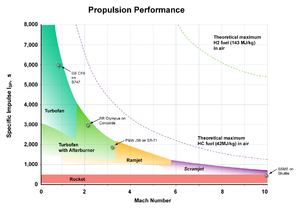
Fuel/propellant consumption
A closely related (but different) concept to energy efficiency is the rate of consumption of propellant mass. Propellant consumption in jet engines is measured by Specific Fuel Consumption, Specific impulse or Effective exhaust velocity. They all measure the same thing, specific impulse and effective exhaust velocity are strictly proportional, whereas specific fuel consumption is inversely proportional to the others.
For airbreathing engines such as turbojets energy efficiency and propellant (fuel) efficiency are much the same thing, since the propellant is a fuel and the source of energy. In rocketry, the propellant is also the exhaust, and this means that a high energy propellant gives better propellant efficiency but can in some cases actually can give lower energy efficiency.
Template:Thrust engine efficiency
It can be seen that the subsonic turbofans such as General Electric's CF6 uses a lot less fuel to generate thrust for a second than Concorde's turbojet, the 593. However, since energy is force times distance and the distance per second is greater for Concorde, the actual power generated by the engine for the same amount of fuel is higher for Concorde at Mach 2 cruise than the CF6- Concorde's engines are more efficient for thrust per mile, indeed, the most efficient ever.[23]
Thrust-to-weight ratio
The thrust to weight ratio of jet engines of similar principles varies somewhat with scale, but mostly is a function of engine construction technology. Clearly for a given engine, the lighter the engine, the better the thrust to weight is, the less fuel is used to compensate for drag due to the lift needed to carry the engine weight, or to accelerate the mass of the engine.
As can be seen in the following table, rocket engines generally achieve very much higher thrust to weight ratios than duct engines such as turbojet and turbofan engines. This is primarily because rockets almost universally use dense liquid or solid reaction mass which gives a much smaller volume and hence the pressurisation system that supplies the nozzle is much smaller and lighter for the same performance. Duct engines have to deal with air which is 2-3 orders of magnitude less dense and this gives pressures over much larger areas, and which in turn results in more engineering materials being needed to hold the engine together and for the air compressor.
Template:Engine thrust to weight table
Comparison of types
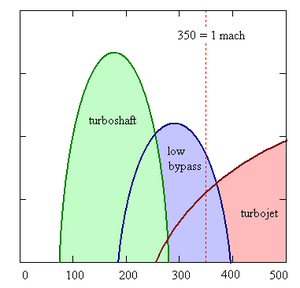
Turboprops obtain little thrust from jet effect, but are useful for comparison. They are gas turbine engines that have a rotating fan that takes and accelerates the large mass of air but by a relatively small change in speed. This low speed limits the speed of any propeller driven airplane. When the plane speed exceeds this limit, propellers no longer provide any thrust (c-v < 0). However, because they accelerate a large mass of air, turboprops are very efficient.
Turbojets accelerate a much smaller mass of the air and burned fuel, but they emit it at the much higher speeds possible with a de Laval nozzle. This is why they are suitable for supersonic and higher speeds.
Low bypass turbofans have the mixed exhaust of the two air flows, running at different speeds (c1 and c2). The thrust of such engine is
- S = m1 (c1 - v) + m2 (c2 - v)
where m1 and m2 are the air masses, being blown from the both exhausts. Such engines are effective at lower speeds, than the pure jets, but at higher speeds than the turboshafts and propellers in general. For instance, at the 10 km altitude, turboshafts are most effective at about Mach 0.4 (0.4 times the speed of sound), low bypass turbofans become more effective at about Mach 0.75 and turbojets become more effective than mixed exhaust engines when the speed approaches Mach 2-3.
Rocket engines have extremely high exhaust velocity and thus are best suited for high speeds (hypersonic) and great altitudes. At any given throttle, the thrust and efficiency of a rocket motor improves slightly with increasing altitude (because the back-pressure falls thus increasing net thrust at the nozzle exit plane), whereas with a turbojet (or turbofan) the falling density of the air entering the intake (and the hot gases leaving the nozzle) causes the net thrust to decrease with increasing altitude. Rocket engines are more efficient than even scramjets above roughly Mach 15.[24]
Altitude and speed
With the exception of scramjets, jet engines, deprived of their inlet systems can only accept air at around half the speed of sound. The inlet system's job for transonic and supersonic aircraft is to slow the air and perform some of the compression.
The limit on maximum altitude for engines is set by flammability- at very high altitudes the air becomes too thin to burn, or after compression, too hot. For turbojet engines altitudes of about 40 km appear to be possible, whereas for ramjet engines 55 km may be achievable. Scramjets may theoretically manage 75 km.[25] Rocket engines of course have no upper limit.
Flying faster compresses the air in at the front of the engine, but ultimately the engine cannot go any faster without melting. The upper limit is usually thought to be about Mach 5-8, except for scramjets which may be able to achieve about Mach 15 or more, as they avoid slowing the air.
Noise
Noise is due to shockwaves that form when the exhaust jet interacts with the external air. The intensity of the noise is proportional to the thrust as well as proportional to the fourth power of the jet velocity.Generally then, the lower speed exhaust jets emitted from engines such as high bypass turbofans are the quietest, whereas the fastest jets are the loudest.
Although some variation in jet speed can often be arranged from a jet engine (such as by throttling back and adjusting the nozzle) it is difficult to vary the jet speed from an engine over a very wide range. Therefore since engines for supersonic vehicles such as Concorde, military jets and rockets inherently need to have supersonic exhaust at top speed, so these vehicles are especially noisy even at low speeds.
Advanced designs
J-58 combined ramjet/turbojet
The SR-71 Blackbird's Pratt & Whitney J58 engines were rather unusual. They could convert in flight from being largely a turbojet to being largely a compressor-assisted ramjet. At high speeds (above Mach 2.4), the engine used variable geometry vanes to direct excess air through 6 bypass pipes from downstream of the fourth compressor stage into the afterburner.[26] 80% of the SR-71's thrust at high speed was generated in this way, giving much higher thrust, improving specific impulse by 10-15%, and permitting continuous operation at Mach 3.2. The name coined for this setup is turbo-ramjet.
Hydrogen fuelled air-breathing jet engines
Jet engines can be run on almost any fuel. Hydrogen is a highly desirable fuel, as, although the energy per mole is not unusually high, the molecule is very much lighter than other molecules. The energy per kg of hydrogen is twice that of more common fuels and this gives twice the specific impulse. In addition, jet engines running on hydrogen are quite easy to build—the first ever turbojet was run on hydrogen. Also, although not duct engines, hydrogen-fueled rocket engines have seen extensive use.
However, in almost every other way, hydrogen is problematic. The downside of hydrogen is its density; in gaseous form the tanks are impractical for flight, but even in the form of liquid hydrogen it has a density one fourteenth that of water. It is also deeply cryogenic and requires very significant insulation that precludes it being stored in wings. The overall vehicle would end up being very large, and difficult for most airports to accommodate. Finally, pure hydrogen is not found in nature, and must be manufactured either via steam reforming or expensive electrolysis. Nevertheless, research is ongoing and hydrogen-fueled aircraft designs do exist that may be feasible.
Precooled jet engines
An idea originated by Robert P. Carmichael in 1955[27] is that hydrogen-fueled engines could theoretically have much higher performance than hydrocarbon-fueled engines if a heat exchanger were used to cool the incoming air. The low temperature allows lighter materials to be used, a higher mass-flow through the engines, and permits combustors to inject more fuel without overheating the engine.
This idea leads to plausible designs like Reaction Engines SABRE, that might permit single-stage-to-orbit launch vehicles,[28] and ATREX, which could permit jet engines to be used up to hypersonic speeds and high altitudes for boosters for launch vehicles. The idea is also being researched by the EU for a concept to achieve non-stop antipodal supersonic passenger travel at Mach 5 (Reaction Engines A2).
Nuclear-powered ramjet
Project Pluto was a nuclear-powered ramjet, intended for use in a cruise missile. Rather than combusting fuel as in regular jet engines, air was heated using a high-temperature, unshielded nuclear reactor. This dramatically increased the engine burn time, and the ramjet was predicted to be able to cover any required distance at supersonic speeds (Mach 3 at tree-top height).
However, there was no obvious way to stop it once it had taken off, which would be a great disadvantage in any non-disposable application. Also, because the reactor was unshielded, it was dangerous to be in or around the flight path of the vehicle (although the exhaust itself wasn't radioactive). These disadvantages limit the application to warhead delivery system for all-out nuclear war, which it was being designed for.
Scramjets
Scramjets are an evolution of ramjets that are able to operate at much higher speeds than any other kind of airbreathing engine. They share a similar structure with ramjets, being a specially-shaped tube that compresses air with no moving parts through ram-air compression. Scramjets, however, operate with supersonic airflow through the entire engine. Thus, scramjets do not have the diffuser required by ramjets to slow the incoming airflow to subsonic speeds.
Scramjets start working at speeds of at least Mach 4, and have a maximum useful speed of approximately Mach 17.[29] Due to aerodynamic heating at these high speeds, cooling poses a challenge to engineers.
Environmental considerations
Jet engines are usually run on fossil fuel propellant, and are thus a source of carbon dioxide in the atmosphere.
Some scientists believe that jet engines are also a source of global dimming due to the water vapour in the exhaust causing cloud formations.
Nitrogen compounds are also formed from the combustion process from atmospheric nitrogen. At low altitudes this is not thought to be especially harmful, but for supersonic aircraft that fly in the stratosphere some destruction of ozone may occur.
Sulphates are also emitted if the fuel contains sulphur.
Safety and reliability
Jet engines are usually very reliable and have a very good safety record. However, failures do sometimes occur.
Compressor blade containment
The most likely failure is compressor blade failure, and modern jet engines are designed with structures that can catch these blades and keep them contained within the engine casing. Verification of a jet engine design involves testing that this system works correctly.
Bird strike
Bird strike is an aviation term for a collision between a bird and an aircraft. It is a common threat to aircraft safety and has caused a number of fatal accidents. In 1988 an Ethiopian Airlines Boeing 737 sucked pigeons into both engines during take-off and then crashed in an attempt to return to the Bahir Dar airport; of the 104 people aboard, 35 died and 21 were injured. In another incident in 1995, a Dassault Falcon 20 crashed at a Paris airport during an emergency landing attempt after sucking lapwings into an engine, which caused an engine failure and a fire in the airplane fuselage; all 10 people on board were killed. A US Airways Airbus A320 aircraft sucked in one bird in each engine. The plane landed in the Hudson River after taking off from LaGuardia International Airport in New York City. There were no fatalities. [30]
Modern jet engines have the capability of surviving an ingestion of a bird. Small fast planes, such as military jet fighters, are at higher risk than big heavy multi-engine ones. This is due to the fact that the fan of a high-bypass turbofan engine, typical on transport aircraft, acts as a centrifugal separator to force ingested materials (birds, ice, etc.) to the outside of the fan's disc. As a result, such materials go through the relatively unobstructed bypass duct, rather than through the core of the engine, which contains the smaller and more delicate compressor blades. Military aircraft designed for high-speed flight typically have pure turbojet, or low-bypass turbofan engines, increasing the risk that ingested materials will get into the core of the engine to cause damage.
The highest risk of the bird strike is during the takeoff and landing, in low altitudes, which is in the vicinity of the airports.
Uncontained failures
One class of failures that has caused accidents in particular is uncontained failures, where rotary parts of the engine break off and exit through the case. These can cut fuel or control lines, and can penetrate the cabin. Although fuel and control lines are usually duplicated for reliability, the crash of United Airlines Flight 232 was caused when hydraulic fluid lines for all three independent hydraulic systems were simultaneously severed by shrapnel from an uncontained engine failure. Prior to the United 232 crash, the probability of a simultaneous failure of all three hydraulic systems was considered as high as a billion-to-one. However, the statistical models used to come up with this figure did not account for the fact that the number-two engine was mounted at the tail close to all the hydraulic lines, nor the possibility that an engine failure would release many fragments in many directions. Since then, more modern aircraft engine designs have focused on keeping shrapnel from penetrating the cowling or ductwork, and have increasingly utilized high-strength composite materials to achieve the required penetration resistance while keeping the weight low.
References
- ↑ Encyclopedia Britannica: Internal Combustion Engine
- ↑ How many air-miles are left in the world’s fuel tank?
- ↑ U.S. Airlines: Operating in an Era of High Jet Fuel Prices
- ↑ propeller efficiency
- ↑ Patent number 554,906
- ↑ Gyorgy, Nagy Istvan, "Albert Fono: A Pioneer of Jet Propulsion", International Astronautical Congress, 1977, IAF/IAA
- ↑ Dugger, Gordon L. (1969). Ramjets. American Institute of Aeronautics and Astronautics, p. 15.
- ↑ Maxime Guillaume,"Propulseur par réaction sur l'air," French patent no. 534,801 (filed: 3 May 1921; issued: 13 January 1922). Available on-line (in French) at: http://v3.espacenet.com/origdoc?DB=EPODOC&IDX=FR534801&F=0&QPN=FR534801 .
- ↑ sod1280.tmp
- ↑ PBS - Chasing the Sun - Frank Whittle
- ↑ BBC - History - Frank Whittle (1907 - 1996)
- ↑ Frank Whittle, "Improvements relating to the propulsion of aircraft and other vehicles," British patent no. 347,206 (filed: 16 January 1930). Available on-line at: http://v3.espacenet.com/origdoc?DB=EPODOC&IDX=GB347206&F=0&QPN=GB347206 .
- ↑ The History of the Jet Engine - Sir Frank Whittle - Hans Von OhainOhain said that he had not read Whittle's patent and Whittle believed him (Frank Whittle 1907-1996) however the Whittle patent was in German libraries and Whittle's son had suspicions that Ohain had read or heard of it (The History of the Jet Engine - Sir Frank Whittle a genius betrayed - )
- ↑ ch10-3
- ↑ [1]
- ↑ Jump up to: 16.0 16.1 [2]
- ↑ [3]
- ↑ [4]
- ↑ Merging Air and Space
- ↑ In Newtonian mechanics kinetic energy is frame dependent. The kinetic energy is easiest to calculate when the speed is measured in the center of mass frame of the vehicle and (less obviously) its reaction mass/air i.e. the stationary frame before takeoff begins.
- ↑ K.Honicke, R.Lindner, P.Anders, M.Krahl, H.Hadrich, K.Rohricht. Beschreibung der Konstruktion der Triebwerksanlagen. Interflug, Berlin, 1968
- ↑ Rocket Propulsion elements- seventh edition, pg 37-38
- ↑ NOVA transcript
- ↑ High Speed Propulsion
- ↑ SCRAMJET
- ↑ J58
- ↑ NASA history Other Interests in Hydrogen
- ↑ The Skylon Spaceplane
- ↑ Astronautix X30
- ↑ Transport Canada - Sharing the Skies
- John Golley (1997). Genesis of the Jet: Frank Whittle and the Invention of the Jet Engine. Crowood Press. ISBN 1-85310-860-X.
- David S Brooks (1997). Vikings at Waterloo: Wartime Work on the Whittle Jet Engine by the Rover Company. Rolls-Royce Heritage Trust. ISBN 1-872922-08-2
See also
Template:Wiktionary Template:Wiktionary
- Air turboramjet
- Balancing machine
- Jet engine performance
- Jet aircraft
- Jetboat
- Turbofan
- Variable Cycle Engine
- Turbojet
- Turboprop
- Turboshaft
- Propfan
- Pulse jet
- Turborocket
- Ramjet
- Rocket engine nozzles
- Spacecraft propulsion
- Supercharger
- Turbocharger
- Afterburner
- Water injection (engines)
- Thrust reversal
- Gas turbine
- Kurt Schreckling who built practical jet engines for model aircraft
- Wikibooks: Jet propulsion
- Hush house
External links
- A New “Open Rotor” Jet Engine That Could Reduce Fuel Consumption
- Technology Speed of Civil Jet Engines
- Animated Jet Engines to understand how it works
- RMCybernetics - A simple Homemade Jet Engine
- Journey through a jet engine(flash)
- How Stuff Works article on how a Gas Turbine Engine works
- Influence of the Jet Engine on the Aerospace Industry
- An Overview of Military Jet Engine History (Rand Corp., 24 pgs, PDF)
- A jet propulsion bicycle
- Basic jet engine tutorial (Quicktime Video
- Jet powered model of an Airbus A330 at 1/16 scale
- Pulsejet in aeromodelling
- Interactive jet engine simulator for learning
Template:Machine configurations
Template:Link FA Template:Link FA Template:Link FA
ar:محرك نفاث az:Reaktiv mühərrik cs:Reaktivní motor da:Jetmotor de:Strahltriebwerk es:Motor a reacción eo:Jetmotoro fa:موتور جت fr:Moteur à réaction ga:Scairdinneall ko:제트 엔진 hy:Ռեակտիվ շարժիչներ hi:जेट इंजन hr:Mlazni motor id:Mesin jet he:מנוע סילון lv:Gāzes strūklas dzinējs hu:Sugárhajtómű ml:ജെറ്റ് എന്ജിന് ms:Enjin jet ja:ジェットエンジン no:Jetmotor pl:Silnik odrzutowy pt:Motor a jato ro:Motor cu reacţie ru:Воздушно-реактивный двигатель sq:Motori reaktiv simple:Jet engine sk:Reaktívny motor sr:Mlazni motor sh:Mlazni motor fi:Suihkumoottori sv:Jetmotor tr:Jet motoru zh:喷气发动机
